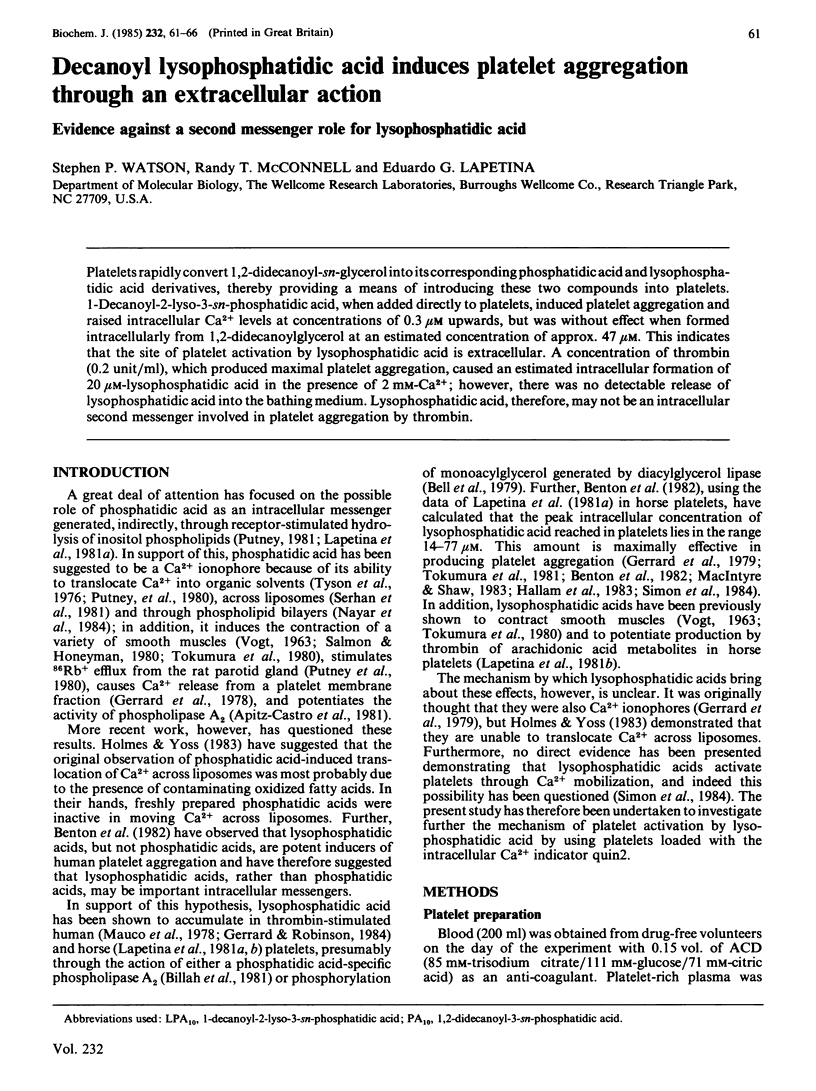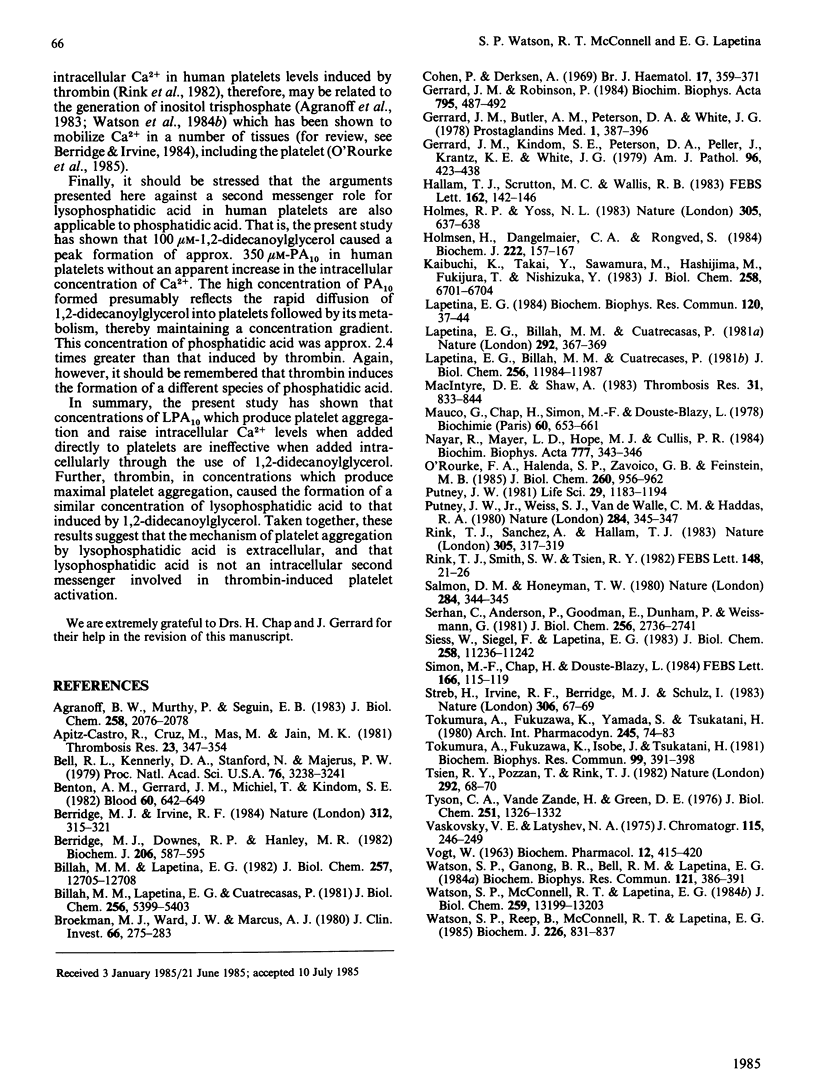Abstract
Platelets rapidly convert 1,2-didecanoyl-sn-glycerol into its corresponding phosphatidic acid and lysophosphatidic acid derivatives, thereby providing a means of introducing these two compounds into platelets. 1-Decanoyl-2-lyso-3-sn-phosphatidic acid, when added directly to platelets, induced platelet aggregation and raised intracellular Ca2+ levels at concentrations of 0.3 microM upwards, but was without effect when formed intracellularly from 1,2-didecanoylglycerol at an estimated concentration of approx. 47 microM. This indicates that the site of platelet activation by lysophosphatidic acid is extracellular. A concentration of thrombin (0.2 unit/ml), which produced maximal platelet aggregation, caused an estimated intracellular formation of 20 microM-lysophosphatidic acid in the presence of 2 mM-Ca2+; however, there was no detectable release of lysophosphatidic acid into the bathing medium. Lysophosphatidic acid, therefore, may not be an intracellular second messenger involved in platelet aggregation by thrombin.
Full text
PDF





Images in this article
Selected References
These references are in PubMed. This may not be the complete list of references from this article.
- Agranoff B. W., Murthy P., Seguin E. B. Thrombin-induced phosphodiesteratic cleavage of phosphatidylinositol bisphosphate in human platelets. J Biol Chem. 1983 Feb 25;258(4):2076–2078. [PubMed] [Google Scholar]
- Apitz-Castro R., Cruz M., Mas M., Jain M. K. Further studies on a phospholipase A2 isolated from human platelet plasma membranes. 1981 Aug 15-Sep 1Thromb Res. 23(4-5):347–354. doi: 10.1016/0049-3848(81)90195-x. [DOI] [PubMed] [Google Scholar]
- Bell R. L., Kennerly D. A., Stanford N., Majerus P. W. Diglyceride lipase: a pathway for arachidonate release from human platelets. Proc Natl Acad Sci U S A. 1979 Jul;76(7):3238–3241. doi: 10.1073/pnas.76.7.3238. [DOI] [PMC free article] [PubMed] [Google Scholar]
- Benton A. M., Gerrard J. M., Michiel T., Kindom S. E. Are lysophosphatidic acids or phosphatidic acids involved in stimulus activation coupling in platelets? Blood. 1982 Sep;60(3):642–649. [PubMed] [Google Scholar]
- Berridge M. J., Downes C. P., Hanley M. R. Lithium amplifies agonist-dependent phosphatidylinositol responses in brain and salivary glands. Biochem J. 1982 Sep 15;206(3):587–595. doi: 10.1042/bj2060587. [DOI] [PMC free article] [PubMed] [Google Scholar]
- Berridge M. J., Irvine R. F. Inositol trisphosphate, a novel second messenger in cellular signal transduction. Nature. 1984 Nov 22;312(5992):315–321. doi: 10.1038/312315a0. [DOI] [PubMed] [Google Scholar]
- Billah M. M., Lapetina E. G., Cuatrecasas P. Phospholipase A2 activity specific for phosphatidic acid. A possible mechanism for the production of arachidonic acid in platelets. J Biol Chem. 1981 Jun 10;256(11):5399–5403. [PubMed] [Google Scholar]
- Billah M. M., Lapetina E. G. Rapid decrease of phosphatidylinositol 4,5-bisphosphate in thrombin-stimulated platelets. J Biol Chem. 1982 Nov 10;257(21):12705–12708. [PubMed] [Google Scholar]
- Broekman M. J., Ward J. W., Marcus A. J. Phospholipid metabolism in stimulated human platelets. Changes in phosphatidylinositol, phosphatidic acid, and lysophospholipids. J Clin Invest. 1980 Aug;66(2):275–283. doi: 10.1172/JCI109854. [DOI] [PMC free article] [PubMed] [Google Scholar]
- Cohen P., Derksen A. Comparison of phospholipid and fatty acid composition of human erythrocytes and platelets. Br J Haematol. 1969 Oct;17(4):359–371. doi: 10.1111/j.1365-2141.1969.tb01382.x. [DOI] [PubMed] [Google Scholar]
- Gerrard J. M., Butler A. M., Peterson D. A., White J. G. Phosphatidic acid releases calcium from a platelet membrane fraction in vitro. Prostaglandins Med. 1978 Nov;1(5):387–396. doi: 10.1016/0161-4630(78)90125-8. [DOI] [PubMed] [Google Scholar]
- Gerrard J. M., Kindom S. E., Peterson D. A., Peller J., Krantz K. E., White J. G. Lysophosphatidic acids. Influence on platelet aggregation and intracellular calcium flux. Am J Pathol. 1979 Aug;96(2):423–438. [PMC free article] [PubMed] [Google Scholar]
- Gerrard J. M., Robinson P. Lysophosphatidic acid can activate platelets without increasing 32P-labelling of phosphatidic acid. Biochim Biophys Acta. 1984 Oct 4;795(3):487–492. doi: 10.1016/0005-2760(84)90177-2. [DOI] [PubMed] [Google Scholar]
- Hallam T. J., Scrutton M. C., Wallis R. B. The role of 1-O-alkyl-2-acetyl-sn-glyceryl-3-phosphorylcholine (AcGEPC) and palmitoyl-lysophosphatidate in the responses of human blood platelets to collagen and thrombin. FEBS Lett. 1983 Oct 3;162(1):142–146. doi: 10.1016/0014-5793(83)81066-7. [DOI] [PubMed] [Google Scholar]
- Holmes R. P., Yoss N. L. Failure of phosphatidic acid to translocate Ca2+ across phosphatidylcholine membranes. Nature. 1983 Oct 13;305(5935):637–638. doi: 10.1038/305637a0. [DOI] [PubMed] [Google Scholar]
- Holmsen H., Dangelmaier C. A., Rongved S. Tight coupling of thrombin-induced acid hydrolase secretion and phosphatidate synthesis to receptor occupancy in human platelets. Biochem J. 1984 Aug 15;222(1):157–167. doi: 10.1042/bj2220157. [DOI] [PMC free article] [PubMed] [Google Scholar]
- Kaibuchi K., Takai Y., Sawamura M., Hoshijima M., Fujikura T., Nishizuka Y. Synergistic functions of protein phosphorylation and calcium mobilization in platelet activation. J Biol Chem. 1983 Jun 10;258(11):6701–6704. [PubMed] [Google Scholar]
- Lapetina E. G., Billah M. M., Cuatrecasas P. Lysophosphatidic acid potentiates the thrombin-induced production of arachidonate metabolites in platelets. J Biol Chem. 1981 Dec 10;256(23):11984–11987. [PubMed] [Google Scholar]
- Lapetina E. G., Billah M. M., Cuatrecasas P. The phosphatidylinositol cycle and the regulation of arachidonic acid production. Nature. 1981 Jul 23;292(5821):367–369. doi: 10.1038/292367a0. [DOI] [PMC free article] [PubMed] [Google Scholar]
- Lapetina E. G. Prostacyclin inhibition of phosphatidic acid synthesis in human platelets is not mediated by protein kinase C. Biochem Biophys Res Commun. 1984 Apr 16;120(1):37–44. doi: 10.1016/0006-291x(84)91410-4. [DOI] [PubMed] [Google Scholar]
- MacIntyre D. E., Shaw A. M. Phospholipid-induced human platelet activation: effects of calcium channel blockers and calcium chelators. Thromb Res. 1983 Sep 15;31(6):833–844. doi: 10.1016/0049-3848(83)90114-7. [DOI] [PubMed] [Google Scholar]
- Mauco G., Chap H., Simon M. F., Douste-Blazy L. Phosphatidic and lysophosphatidic acid production in phospholipase C-and thrombin-treated platelets. Possible involvement of a platelet lipase. Biochimie. 1978 Sep 29;60(6-7):653–661. doi: 10.1016/s0300-9084(78)80784-6. [DOI] [PubMed] [Google Scholar]
- Nayar R., Mayer L. D., Hope M. J., Cullis P. R. Phosphatidic acid as a calcium ionophore in large unilamellar vesicle systems. Biochim Biophys Acta. 1984 Nov 7;777(2):343–346. doi: 10.1016/0005-2736(84)90438-3. [DOI] [PubMed] [Google Scholar]
- O'Rourke F. A., Halenda S. P., Zavoico G. B., Feinstein M. B. Inositol 1,4,5-trisphosphate releases Ca2+ from a Ca2+-transporting membrane vesicle fraction derived from human platelets. J Biol Chem. 1985 Jan 25;260(2):956–962. [PubMed] [Google Scholar]
- Putney J. W., Jr Recent hypotheses regarding the phosphatidylinositol effect. Life Sci. 1981 Sep 21;29(12):1183–1194. doi: 10.1016/0024-3205(81)90221-6. [DOI] [PubMed] [Google Scholar]
- Putney J. W., Jr, Weiss S. J., Van De Walle C. M., Haddas R. A. Is phosphatidic acid a calcium ionophore under neurohumoral control? Nature. 1980 Mar 27;284(5754):345–347. doi: 10.1038/284345a0. [DOI] [PubMed] [Google Scholar]
- Rink T. J., Sanchez A., Hallam T. J. Diacylglycerol and phorbol ester stimulate secretion without raising cytoplasmic free calcium in human platelets. Nature. 1983 Sep 22;305(5932):317–319. doi: 10.1038/305317a0. [DOI] [PubMed] [Google Scholar]
- Rink T. J., Smith S. W., Tsien R. Y. Cytoplasmic free Ca2+ in human platelets: Ca2+ thresholds and Ca-independent activation for shape-change and secretion. FEBS Lett. 1982 Nov 1;148(1):21–26. doi: 10.1016/0014-5793(82)81234-9. [DOI] [PubMed] [Google Scholar]
- Salmon D. M., Honeyman T. W. Proposed mechanism of cholinergic action in smooth muscle. Nature. 1980 Mar 27;284(5754):344–345. doi: 10.1038/284344a0. [DOI] [PubMed] [Google Scholar]
- Serhan C., Anderson P., Goodman E., Dunham P., Weissmann G. Phosphatidate and oxidized fatty acids are calcium ionophores. Studies employing arsenazo III in liposomes. J Biol Chem. 1981 Mar 25;256(6):2736–2741. [PubMed] [Google Scholar]
- Siess W., Siegel F. L., Lapetina E. G. Arachidonic acid stimulates the formation of 1,2-diacylglycerol and phosphatidic acid in human platelets. Degree of phospholipase C activation correlates with protein phosphorylation, platelet shape change, serotonin release, and aggregation. J Biol Chem. 1983 Sep 25;258(18):11236–11242. [PubMed] [Google Scholar]
- Simon M. F., Chap H., Douste-Blazy L. Platelet aggregating activity of lysophosphatidic acids is not related to their calcium ionophore properties. FEBS Lett. 1984 Jan 23;166(1):115–119. doi: 10.1016/0014-5793(84)80055-1. [DOI] [PubMed] [Google Scholar]
- Streb H., Irvine R. F., Berridge M. J., Schulz I. Release of Ca2+ from a nonmitochondrial intracellular store in pancreatic acinar cells by inositol-1,4,5-trisphosphate. Nature. 1983 Nov 3;306(5938):67–69. doi: 10.1038/306067a0. [DOI] [PubMed] [Google Scholar]
- Tokumura A., Fukuzawa K., Isobe J., Tsukatani H. Lysophosphatidic acid-induced aggregation of human and feline platelets: structure-activity relationship. Biochem Biophys Res Commun. 1981 Mar 31;99(2):391–398. doi: 10.1016/0006-291x(81)91758-7. [DOI] [PubMed] [Google Scholar]
- Tokumura A., Fukuzawa K., Yamada S., Tsukatani H. Stimulatory effect of lysophosphatidic acids on uterine smooth muscles of non-pregant rats. Arch Int Pharmacodyn Ther. 1980 May;245(1):74–83. [PubMed] [Google Scholar]
- Tsien R. Y., Pozzan T., Rink T. J. T-cell mitogens cause early changes in cytoplasmic free Ca2+ and membrane potential in lymphocytes. Nature. 1982 Jan 7;295(5844):68–71. doi: 10.1038/295068a0. [DOI] [PubMed] [Google Scholar]
- Tyson C. A., Vande Zande H., Green D. E. Phospholipids as ionophores. J Biol Chem. 1976 Mar 10;251(5):1326–1332. [PubMed] [Google Scholar]
- VOGT W. Pharamacologically active acidic phospholipids and glycolipids. Biochem Pharmacol. 1963 Apr;12:415–420. doi: 10.1016/0006-2952(63)90074-1. [DOI] [PubMed] [Google Scholar]
- Vaskovsky V. E., Latyshev N. A. Modified Jungnickel's reagent for detecting phospholipids and other phosphorus compounds on thin-layer chromatograms. J Chromatogr. 1975 Dec 10;115(1):246–249. doi: 10.1016/s0021-9673(00)89042-1. [DOI] [PubMed] [Google Scholar]
- Watson S. P., Ganong B. R., Bell R. M., Lapetina E. G. 1,2-Diacylglycerols do not potentiate the action of phospholipases A2 and C in human platelets. Biochem Biophys Res Commun. 1984 May 31;121(1):386–391. doi: 10.1016/0006-291x(84)90734-4. [DOI] [PubMed] [Google Scholar]
- Watson S. P., McConnell R. T., Lapetina E. G. The rapid formation of inositol phosphates in human platelets by thrombin is inhibited by prostacyclin. J Biol Chem. 1984 Nov 10;259(21):13199–13203. [PubMed] [Google Scholar]
- Watson S. P., Reep B., McConnell R. T., Lapetina E. G. Collagen stimulates [3H]inositol trisphosphate formation in indomethacin-treated human platelets. Biochem J. 1985 Mar 15;226(3):831–837. doi: 10.1042/bj2260831. [DOI] [PMC free article] [PubMed] [Google Scholar]




